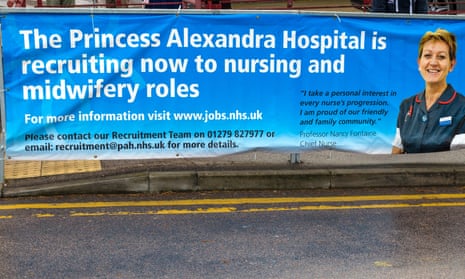“It’s not your normal job; we’re mending lives,” says actor Maxine Peake, in her voiceover to the video spearheading the NHS’s new £8m recruitment campaign, its biggest ever. The health service is growing: in the 12 months to the end of March, the number of NHS staff in England rose by almost 20,000 to 1.2 million.
More surprising, perhaps, is that what is officially defined by the Office for National Statistics as public sector employment as a whole also recorded an underlying increase across the UK in 2017-18, the first time since 2009. The number of staff in central government rose more than 100,000 (3.5%), due in part to extra civil servants for Brexit planning. But some other key public professions – the police and what is classified as public administration, including regulation and inspection and the courts – also grew, indicating the tide may be turning after years of austerity.
“There are a few straws in the wind to suggest that the system may be creaking a bit and we are reaching the limits of reduction,” says Nigel Meager, director of the Institute for Employment Studies. “It’s certainly clear that central government employment is growing quite significantly.”
If the tide is turning, it has a long way to roll back. There are 17% fewer jobs classified as public sector than in September 2009, when they peaked at almost 6.5 million. That’s a loss of 1.1 million.
Some of the fall is attributable to reclassification of former “public sector” jobs as private sector – the 2017-18 underlying increase is arrived at only after discounting the reclassification in December 2017 of more than 100,000 staff of English housing associations – but most of the decline stems from spending cuts.
What’s more, the public sector continues to shrink as a proportion of the national workforce as a whole, as the private sector is growing faster. As of March this year, the public sector represented 16.5% of the total UK workforce – the smallest share since comparable records began in 1999.
And working in the public cause is significantly less rewarding than it used to be.“Millions of hard-working public servants haven’t had a real-terms pay rise in nearly a decade, and for many the latest pay deals still won’t deliver one,” says TUC general secretary Frances O’Grady. “Departmental budgets have been slashed. And even after the collapse of [outsourcing contractor] Carillion, vital services are still in private hands.
“Ministers simply aren’t giving our public services – and our public servants – the respect and investment they deserve.”
Local government is undoubtedly the prime illustration of this. Numbers employed by councils have dropped every quarter since June 2010 and continue to fall. There were cuts of 65,000 (3.1%) across the UK in 2017-18. The total for local government (in which the ONS includes education, police and other health and social care staff) at that 2010 peak was 2.9 million; now it is less than 2.1 million, again the lowest figure since 1999. By contrast, numbers in central government stand at 3.1 million, the highest since 1999.
“Local authority employment has declined dramatically and, as far as one can see, continues to decline,” says Meager. “The big question is, how much longer can that go on?”
When jobs are outsourced to private or not-for-profit contractors, they disappear from the official public sector count. So some of the 800,000 local government jobs lost since 2010 will still exist under other categories, albeit almost certainly with inferior pay and conditions. However, Meager thinks that traditional assumptions about better pay in the public sector have been eroded by curbs in place since 2011 – an initial freeze, followed in 2013 by a 1% cap on annual increases.
“There is pretty well no pay advantage in the public sector any more,” he says. “But on most measures there are other, non-wage, advantages, to being in the public sector. You tend to have longer holidays, you tend to have shorter working hours, the likelihood of being made redundant is still lower and, notwithstanding some changes to public sector schemes, occupational pensions are still a lot better.”
Is the public sector employment picture in the UK comparable with other countries? On numbers relative to size of national workforces, the most recent comprehensive data, for 2013, puts the UK just above average. But some other European countries clearly hold public service in higher esteem: in France, often ridiculed for its bureaucracy, a fonctionnaire or civil servant is a much sought-after career; in Germany, an elite civil servant or Beamter enjoys special privileges enshrined in law.
Meager suggests that while some NHS workers, especially doctors and nurses, are held in high regard, public service generally no longer commands the level of respect it once did in the UK. This would seem to be very much the case in social care, with an annual turnover rate approaching 30%, 90,000 vacancies at any one time and pay typically at or very near the legal minimum. Yet with 1.6 million jobs in England alone, it is one of the biggest sectors of the economy.
Might that change? Social care has been promised an NHS-style recruitment drive this autumn, but rewards seem pegged to limited available public funding.
More widely, though, Meager sees some reason for optimism about the outlook for public service from an unlikely source.
“Good deal, bad deal or no deal, the economy is going to take a hit from Brexit,” he argues. “But there will be a lot of public sector jobs associated with administering the spin-off. That opens up the question of Brexit perhaps surprisingly adding a new twist to the public-private balance.”
- David Brindle is the Guardian’s public services editor

